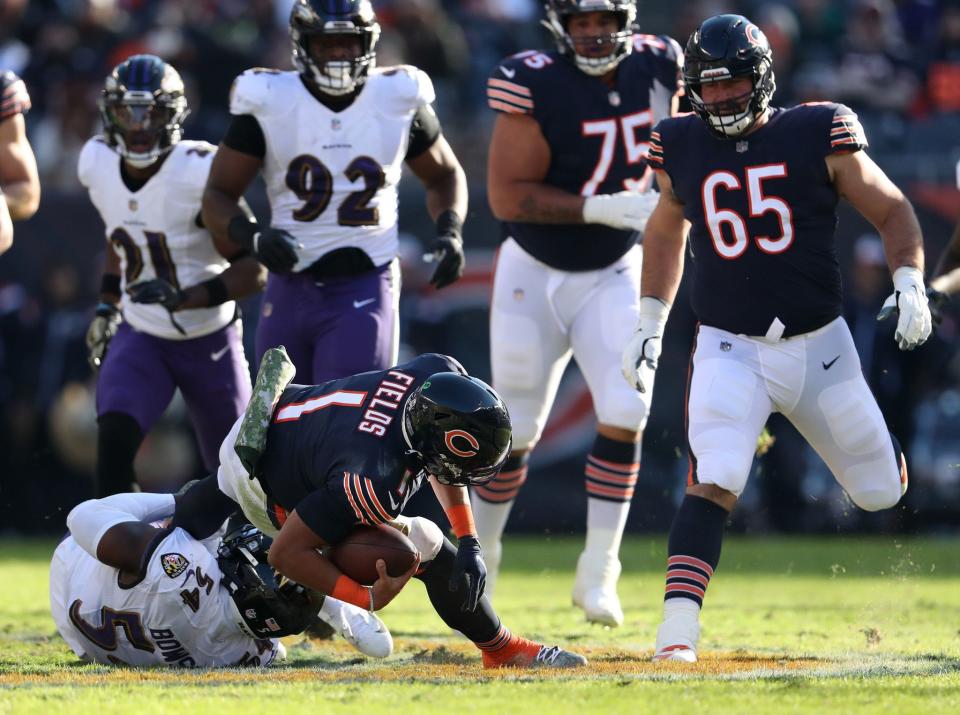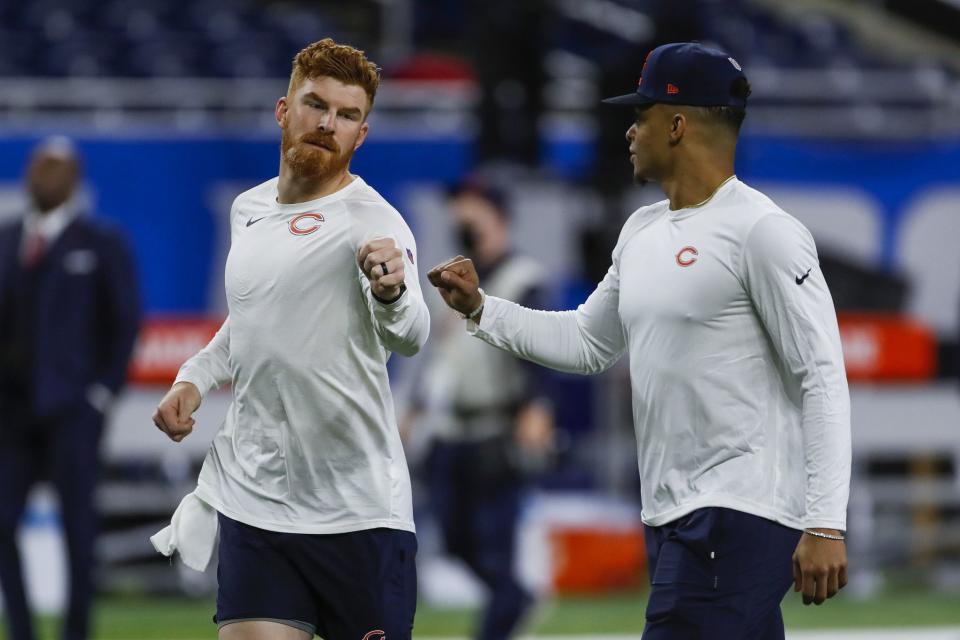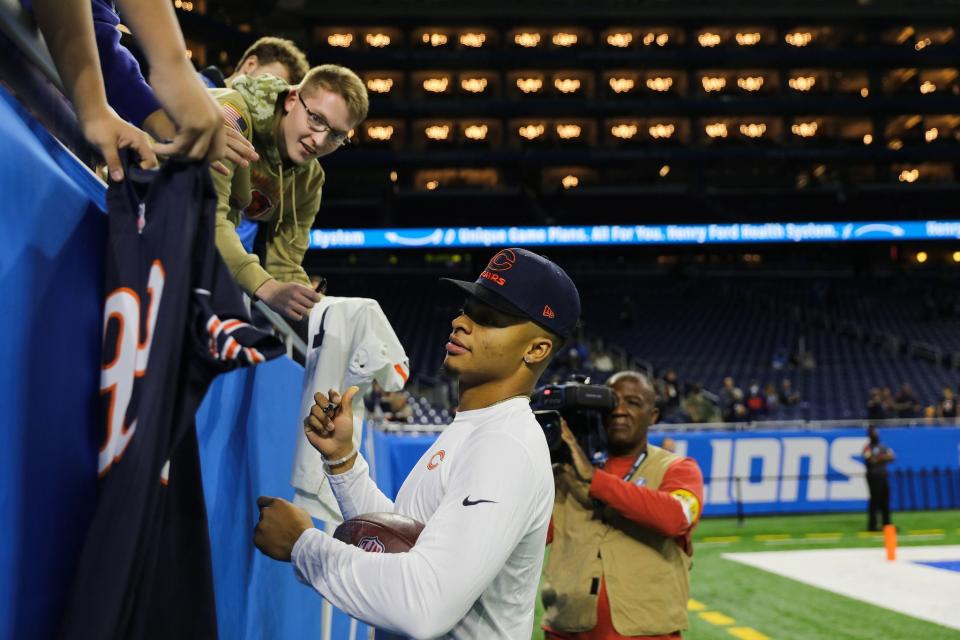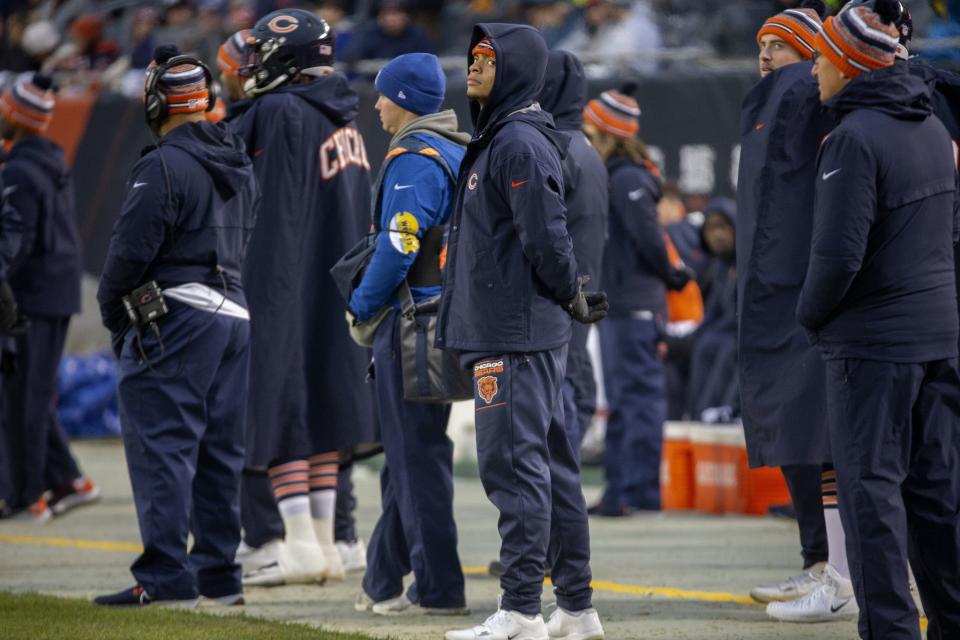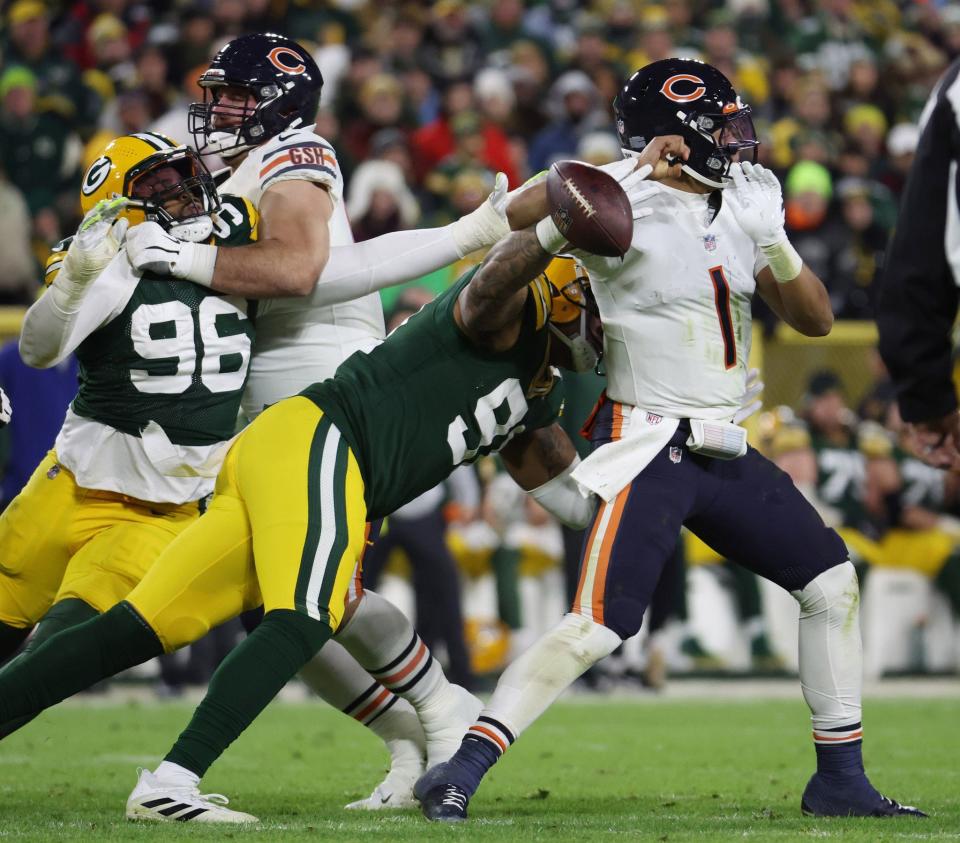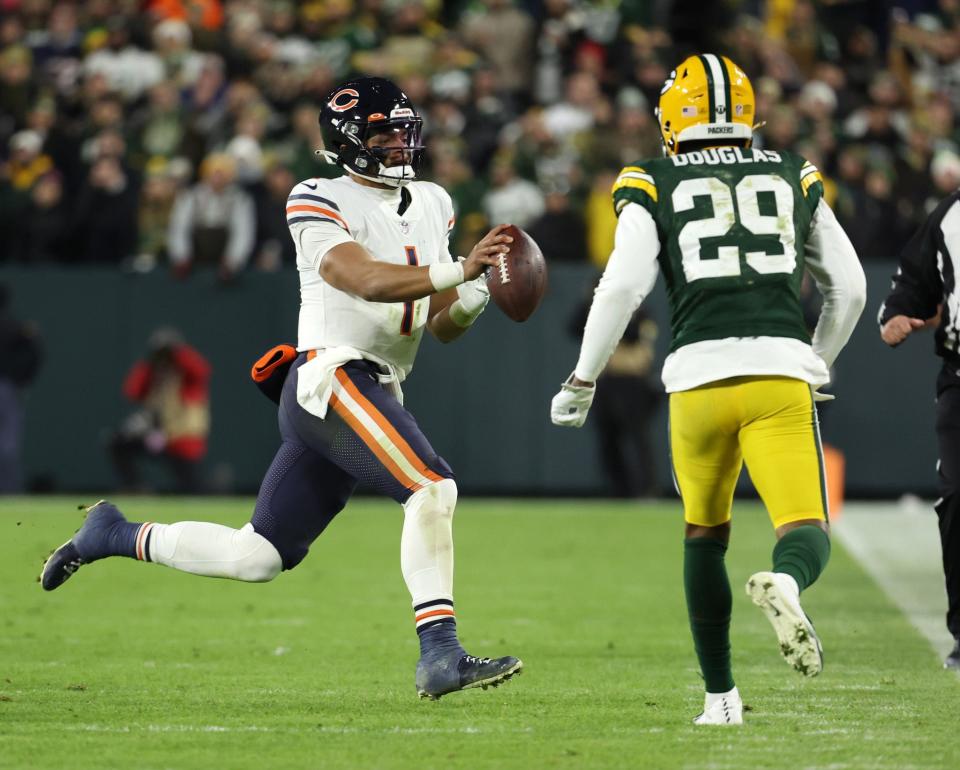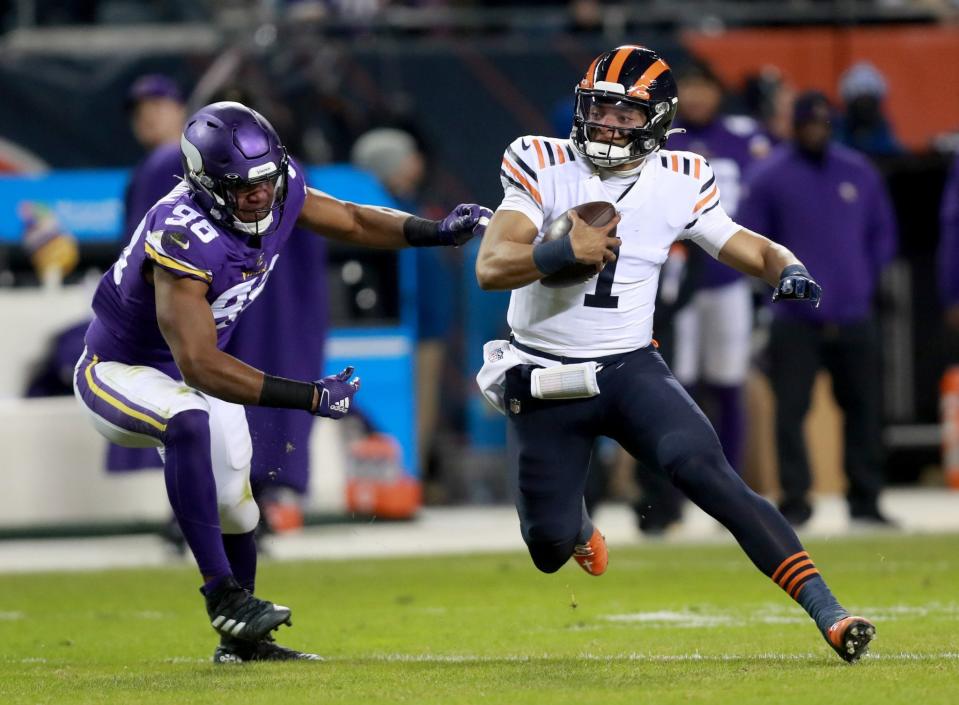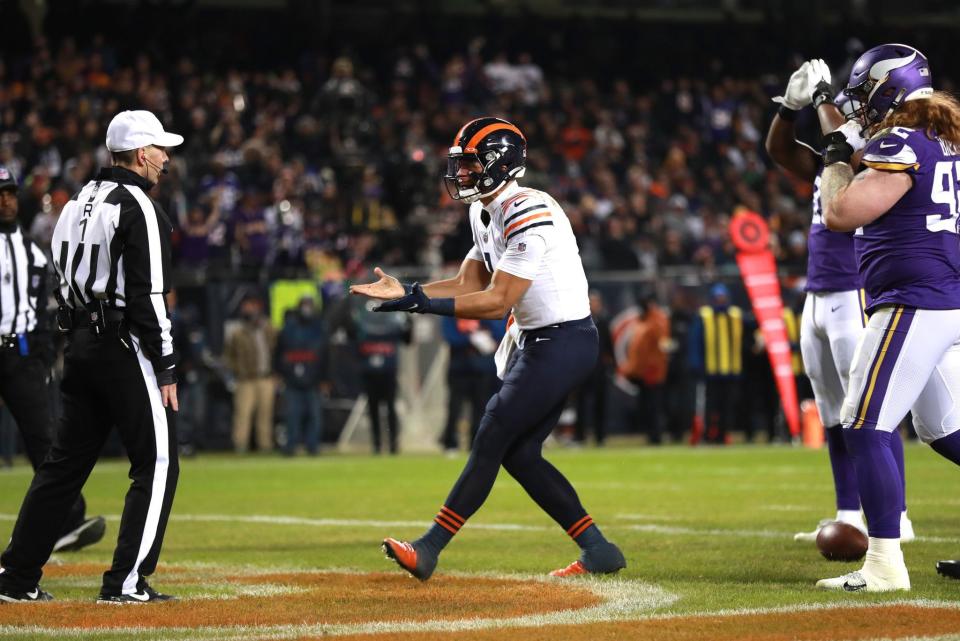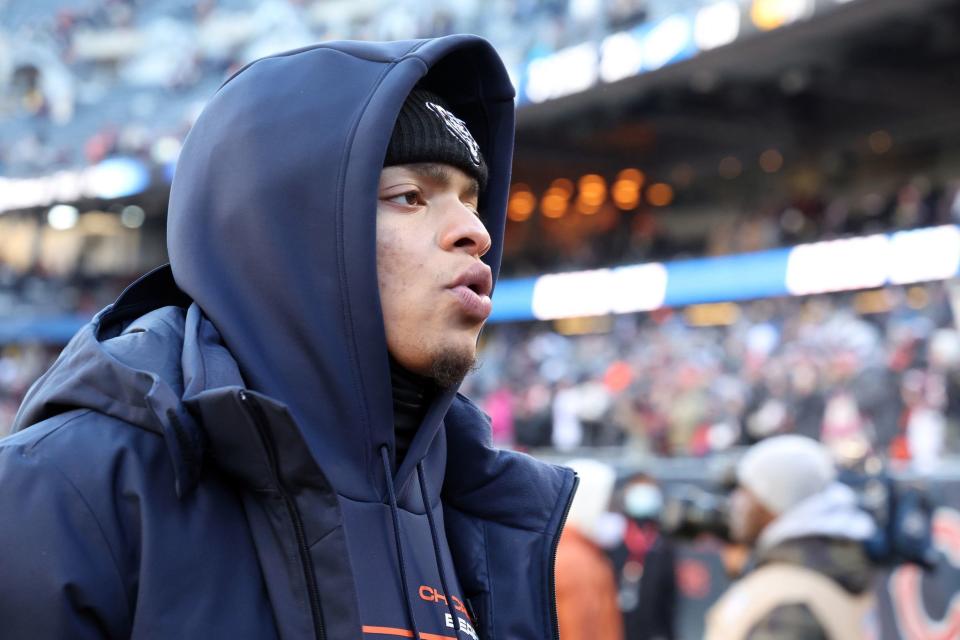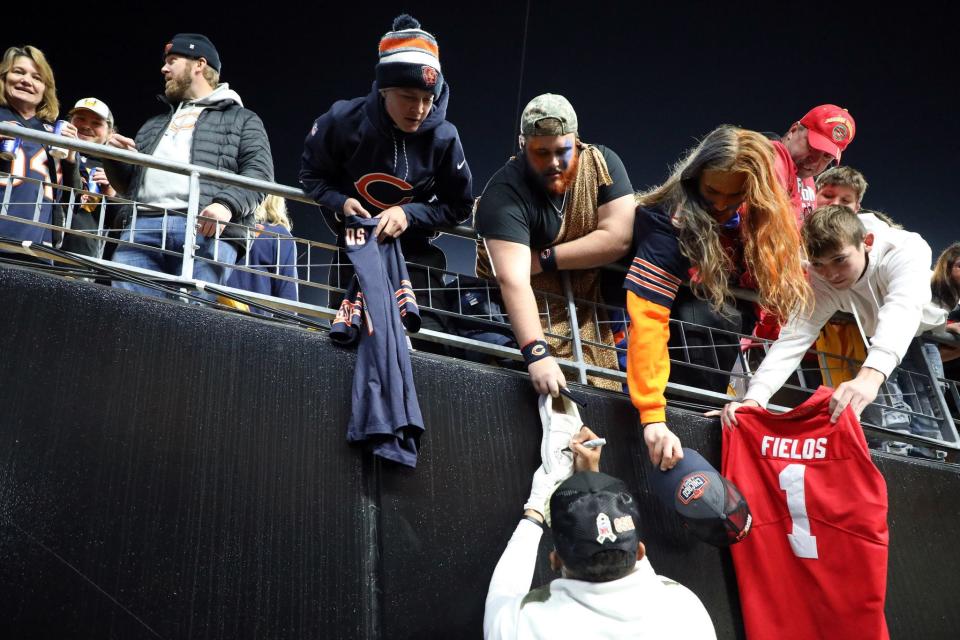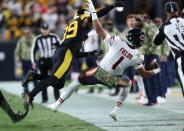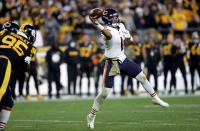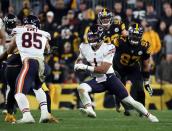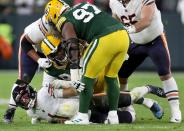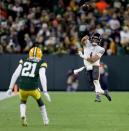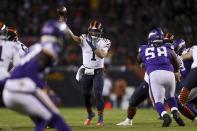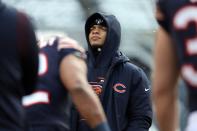Justin Fields and the Chicago Bears offense found ‘more of an identity’ on an encouraging day. Now they need to build on it.
It didn’t take long for Chicago Bears quarterback Justin Fields to find his first completion Sunday against the Denver Broncos. First snap, out of a diamond formation. Play action, tight end to the flat. Easy pitch and catch. Nine-yard gain to Robert Tonyan.
That’s how the Bears always want to start. Straightforward concept. Crisp execution. Positive momentum. Stack the completions from there.
Two in a row for Fields. Three in a row. Four.
Five in a row, six.
Fields’ seventh consecutive completion came on the first play of the second quarter, a deep shot to his favorite receiver. Against a single-high safety look, DJ Moore gained outside leverage against cornerback Ja’Quan McMillian down the right sideline. And when Fields’ pass dropped toward Soldier Field’s north end zone, Moore made a highlight-reel grab, somehow managing to get both feet down inbounds.
Touchdown.
Ideal. Keep that flowing. Stay in the rhythm.
Eight completions in a row. Then nine — another TD pass, this time to tight end Cole Kmet for 22 yards in a massive space in the Broncos zone.
This, apparently, is what the Bears offense had been hunting through September to no avail. Big plays. Timing. Command. Accuracy.
“I felt like there was more of an identity to the offense,” Kmet said. “You could feel that out there.”
Fields rolled up 10 consecutive completions, then 11, then 12 — a third first-half TD pass, again to Kmet from 3 yards away.
Then came 13 in a row. And 14, 15 and 16, a franchise record in the final minute of the first half.
By the end of three quarters, Fields had misfired only once in 24 attempts — and that came on a Hail Mary to end the first half.
Heading into the fourth, Fields had 285 passing yards with energy pulsing through the offense.
Yes, the Bears frittered away a 28-7 lead in an absolutely gut-wrenching 31-28 loss at Soldier Field. And, yes, Fields’ two fourth-quarter turnovers — a fumble returned for a touchdown and an interception on his final pass in the final minute — were a huge part of that story.
But for the first time in forever, the passing offense seemed alive and the Bears’ overall productivity felt encouraging.
“I do think we took a step closer in finding our identity as an offense,” Fields said Tuesday.
Fields finished with a career-high 335 passing yards on a career-high 28 completions with a career-high four tthrows.
Does it matter that it came against the disjointed Broncos, who have allowed a league-worst 461.5 yards per game this season?
“Everybody in this league is really, really good,” offensive coordinator Luke Getsy said. “I wouldn’t take that for anything as far as who we are playing against. And every challenge is different as well.”
The Bears racked up 471 total yards against the Broncos, their sixth-highest output of the last 10 seasons and their best since September 2018, when Matt Nagy was establishing himself as a Coach of the Year front-runner and Mitch Trubisky was a green quarterback brimming with promise.
In addition to Fields’ 300-yard output, Moore turned eight catches into 131 yards and running back Khalil Herbert churned out 103 yards on the ground. It was the first time since December 2016 that the Bears had a 300-yard passer, 100-yard receiver and 100-yard rusher in the same game.
Now come the important questions: What, from within that offensive outburst, carries forward? How much can translate in a new week against a better defense? Will the renewed confidence from Sunday’s performance propel the Bears on Thursday night against the Washington Commanders at Fed Ex Field?
“It’s part of the next step,” Getsy said. “We have to make sure we can consistently execute. … (Against the Broncos) the execution part of it, the communication part, was all pretty crisp. And therefore it gave Justin an opportunity to play at a high level.”
Thursday’s challenge won’t be easy, particularly in a short week. The Commanders defense, overseen by coach Ron Rivera and coordinator Jack Del Rio, has much more teeth than the unit the Broncos brought to Soldier Field, particularly up front with tackles Jonathan Allen and Daron Payne denting the pocket and Chase Young and Montez Sweat coming off the edge.
Getsy labeled the Commanders defense as “loaded” with “as good of a front five as there is in this league.”
“It’s a challenge,” he added. “We have to do a really good job to try to be creative and get every aspect of our game going.”
To have any chance at snapping their 14-game skid, the Bears will have to protect well up front, reduce penalties and take care of the football. But within Sunday’s offensive outburst — which included six completions for at least 20 yards — the Bears consistently found answers and made plays.
In the second quarter alone, they scored 21 points while facing only one third down.
“(We were) just playing fast and confident and not trying to outthink people or be (overly) creative,” Tonyan said. “Just go out there and play.”
Fields’ first touchdown pass to Kmet featured a well-timed call against the ideal zone coverage.
“Favorite play in football: all-go,” Kmet said. “They gave us the look we wanted. All I had to do was buzz that linebacker and put him in conflict with our running back. Justin saw it right away and hit the seam. I knew off the snap it was going to be a touchdown.”
Fields’ two shorter touchdown throws — the 3-yarder to Kmet and a 2-yard dart to Herbert in the third quarter — were more impressive.
On the former, the Bears quarterback rolled right on a play-action bootleg with an ideal blend of purpose and patience. The way outside linebacker Nik Bonitto and safety Kareem Jackson defended the play took away Kmet’s route to the flat. Fields resisted the urge to tuck and run for the end zone. Instead he manipulated linebacker Alex Singleton with his eyes and pacing, then used point-guard vision to drop a dime to Kmet.
“I just tried to stretch the play out as long as possible,” Fields said.
Added Kmet: “He just gave it time for the linebacker to fly through and then dumped it off. It was a good play by Justin to have that vision and that patience to let me find the void there.”
On the touchdown to Herbert, Field reacted to the “dirty edge” he had on his play-action naked bootleg left. He stopped, dodged and veered around Bonitto. And with his eyes up and arm ready, Fields rifled an on-time pass to Herbert across the goal line.
“Pretty special,” Getsy said. “You get into those low (red) zone areas, and that’s what we talk about all the time — quarterbacks extending plays. I would imagine half the scores in the league come from that.
“Him being able to do that there — create some extra time, get some space, get the defense running a little bit — that was a really cool play to see.”
Those are moments to build on, examples of an offense that’s improving and a quarterback who’s seizing opportunities to make plays.
Asked Tuesday for his personal favorite play from a career day, Fields chose a third-and-10 conversion on the Bears’ final touchdown drive — a decisive 11-yard dart into a tight window to Moore with pressure in his face after center Lucas Patrick prematurely snapped the ball.
“My boy Lucas blacked out and snapped it on the first ‘Set-go!’” Fields said. “That’s why we had some guys unblocked. But we call those no-flinch throws — just staying in the pocket and delivering the strike.”
Two plays after facing second-and-18, the Bears had a first down in Broncos territory. Eight plays after that, with Fields’ touchdown pass to Herbert, they were back in the end zone and back in the groove.
“I think everybody definitely took a step and is more confident going into this week,” Fields said.
Now it will be interesting to see how they build from here.





